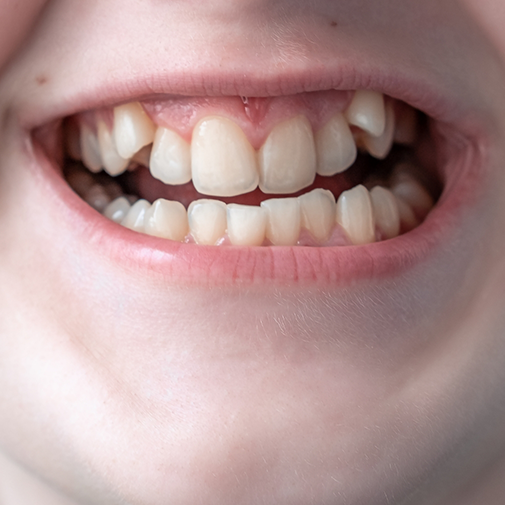Phase 1 Orthodontics Columbus
Ensuring the Health & Future of Your Child’s Smile

The American Association of Orthodontics recommends that once a child reaches the age of seven, they should undergo an orthodontic exam. Since most primary teeth are now firmly in place, a board-certified orthodontist can more easily view any abnormalities associated with their teeth, jaw, and facial development. Wigal Orthodontics of COlumbus aims to address potential issues with Phase 1 Orthodontics. Consisting of braces or other similar appliances, this process can correct problems associated with baby teeth and jaw alignment so that a child can avoid more extensive and complex treatment in the future. If you think your child might benefit from early orthodontic intervention in Columbus, call our office today.
Does My Child Need Phase 1 Orthodontics?

A thorough examination from a qualified orthodontist is the only way to know for sure if your child needs Phase 1 Orthodontics; however, if you or a member of our team notice any of the following, they will likely be cleared for treatment:
- Their teeth appear crowded, crooked, or gapped
- They practice non-nutrient habits, like thumb-sucking or tongue-thrust
- Their teeth are protruding
- They have a lisp or another similar speech impediment
- Their bite is misaligned, causing their teeth to not come together correctly
- They’re unable to breathe freely
- Their baby teeth are keeping permanent ones from erupting correctly
- Their jaw is not in proportion with their head
It’s important to remember that your child’s oral features and facial structures are constantly changing. If Phase 1 Orthodontics is not recommended at this time, it doesn’t mean that it won’t be suggested within a year or two. Dr. Wigal or Dr. Kluemper will continue to monitor the growth of their teeth, jaw, and bite to determine if early treatment is necessary.
What Happens After Phase 1 Orthodontics?

Many children who receive Phase 1 Orthodontics may not require additional treatment in the future; however, this is not always the case. Our team at Wigal Orthodontics of Columbus will cease further care after the initial phase is completed to allow your child’s mouth to continue growing. Once more permanent teeth erupt, we will conduct another evaluation to decide whether Phase 2 Orthodontics is required. This may be necessary if adult teeth need correction.
Things to Remember About Phase 1 Orthodontics

There are some helpful things to remember when it comes to Phase 1 Orthodontics, especially if you’re unsure whether your child should move forward with treatment:
- The younger your child is when receiving orthodontics, the easier it is for the appliances to move their teeth and bones. The reason is that full oral and facial development is not yet complete, so you can expect to see faster results as well.
- Seeing a highly qualified, reliable orthodontist like Dr. Wigal or Dr. Kluemper will ensure that your child is treated properly. Their expertise in the field and ability to identify problems early on can minimize the chances of more invasive and extensive orthodontic care later on.
- Phase 1 treatment might be enough to address the problem area that Phase 2 treatment may not be necessary.
Phase 1 Orthodontics FAQs
When Does Phase 1 Orthodontics Take Place?
Phase 1 orthodontics refers to realignment treatments that take place when the patient is between the ages of six and nine, which is when most children begin losing their baby teeth. These treatments allow an orthodontist to address irregularities in the growth and development of your child’s jaws and teeth since these issues are easier to resolve in a person’s younger years. The American Association of Orthodontists recommends that children receive an evaluation with a qualified orthodontic provider such as Dr. Wigal or Kluemper no later than the age of seven since this is when a child’s first set of permanent molars emerge. This establishes the back of the bite and can help give the oral health professional a fair idea of how the child’s teeth are developing.
What Issues Can Phase 1 Orthodontics Address?
Phase 1 orthodontics can address a variety of tooth and jaw problems in their early stages. These treatments can resolve issues like extreme crowding and spacing as well as teeth protruding too far and the early or late loss of baby teeth. Orthodontic services can also resolve malocclusions such as overbites, underbites, open bites, and crossbites. In some cases, phase 1 orthodontic treatment can be used to make room in the patient’s mouth so the permanent teeth can emerge properly.
What Appliances Are Used in Phase 1 Orthodontics?
Appliances used for phase 1 orthodontics are not as complex as many of those used to straighten teeth at later ages. If the child’s smile is overcrowded, we may recommend using a palate expander to create more space on the upper jaw. If the child has lost a baby tooth too early, we may be able to use a space maintainer to prevent the gap from closing before the permanent one emerges. Kids with severe alignment issues may need braces, but the wires and brackets used for phase 1 orthodontics will only be fastened to a few teeth since the jaw and smile are still developing. In some cases, steel crowns placed on the molars can correct jaw imbalances and help a child achieve a healthier bite. After phase 1 orthodontics, your child will need to wear a retainer to keep their smile properly aligned while the adult teeth emerge.
Is Phase 1 Orthodontics Painful?
The process of placing your child’s orthodontic devices is painless, but you can expect them to experience discomfort for several days afterward. While this stress will be temporary, you can address it with over-the-counter pain relievers and cold compresses. Forgoing a needed orthodontic treatment, on the other hand, can set your child up to experience even more painful oral and overall health issues later in life.













